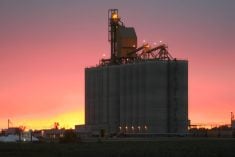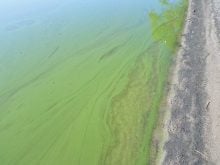At this stage in the crop year, many farmers are thinking about making a late-season application of glyphosate to control perennial weeds. A pre-harvest pass can be effective weed control, but if it’s applied at the wrong time or under the wrong conditions, it’s just wasted time and money. Farmers shouldn’t rely on it to desiccate a crop, contrary to popular belief.
“Weed control should be the primary consideration in the decision to use glyphosate prior to harvest,” says Brent Flaten, integrated pest management specialist with the Saskatchewan Ministry of Agriculture. “Glyphosate is not a desiccant; it’s very slow to dry down crop material. It’s not quick acting like Reglone.”
Read Also

Cancer agency reclassifies another herbicide ‘probably carcinogenic’
The WHO’s cancer research agency has now put atrazine, a herbicide well known to corn growers, in the same potential-hazard category where the agency put glyphosate.
GLYPHOSATE IS NOT A DESICCANT
“In a lot of instances, it’s mistakenly used as a desiccant,” says Dale Risula, provincial specialist for specialty crops with the Saskatchewan Ministry of Agriculture. He says that lentil growers should avoid it entirely in pre-harvest applications on that crop. “It would probably be wise not to use glyphosate as a pre-harvest treatment for weed control (in lentils),” he says. The reason is the acceptable limit for glyphosate residue on imported lentils is much lower in Europe than in Canada and the U.S.
“They (Europeans) have a one-part- per-million residue limit on lentils,” he says. “In Canada, it’s four and in the U.S. it’s five.” From a practical standpoint, it may be impossible to achieve a level that low after making a pre-harvest pass. “The timing of application is really crucial,” he says. “In the event it’s applied too early, you can even get glyphosate levels above our own limits.”
Flaten agrees, and he says if perennial weeds are a problem in a lentil crop, it may be best to wait until after harvest to try and control them. “Considering the European limit, it’s best to try and control those weeds in another crop year and just go with Reglone (for desiccation).” Use of that product does meet with E.U. approval.
GLYPHOSATE FOR WEED CONTROL
But even if a farmer doesn’t intend to try using glyphosate as a desiccant, getting the timing right is still critical to ensure it’s effective at controlling perennial weeds. The only way to ensure that happens is to scout the field first.
“It’s not just a matter of automatically going out there and spraying every year, it’s looking at what weeds you have, what weeds pre-harvest (applications) work best on and what weeds need post-harvest (applications),” says Flaten. “Depending on what weeds you’re going after, you may not want to use pre-harvest as a weed control method.”
“If the condition of the target weed is poor or it’s completed its life cycle, then pre-harvest glyphosate may give poor weed control,” says Flaten. Foxtail barley is a prime example. “Pre-harvest application of glyphosate isn’t the best time to control it. Often the leaves have dried down by pre-harvest. Perennial sow thistle is another example. It’s lost a lot of its leaves (at that time of year) so you don’t get much herbicide entering the plant. You get reduced control.”
Even though foxtail barley may be too mature for herbicide control at pre-harvest, cutting the crop may stimulate its regrowth. Hitting a field with a post-harvest application when plants are active again may be a better alternative (see a story on this topic on page seven).
Post-harvest may also be a better time to control dandelions. A dense crop canopy can prevent spray droplets from landing on their leaves, which are close to the ground. Once the crop is removed, getting glyphosate onto leaves could be much easier, providing they aren’t covered with too much residue.
PROPER TIMING
Making a pre-harvest application too early will also limit its effectiveness, especially with weeds like Canada thistle that are still actively moving resources out of their roots for plant growth. “If you make that pre-harvest application too early in August, you won’t get much (glyphosate) movement into the root system,” says Flaten. The most effective time to apply it is when weeds are actively building winter root reserves.
If you made a spring herbicide
application of glyphosate, ensure target weeds have recovered and have enough regrowth for the second treatment to be effective. “You want the weed to be growing,” says Flaten.
Grassy perennial weeds can usually be controlled well with an early pre-harvest application, but broadleaf weeds are best controlled later in the fall. When daylight hours are reduced, that signals broadleaf perennials to start storing food reserves in their roots, which is the ideal time for translocation of applied glyphosate into that root system. “You tend to get good root and long-term control of broadleaf perennials, such as Canada thistle, later on in August or early September,” says Flaten.
Farmers should also be sure to check with their grain buyer to
ensure a pre-harvest glyphosate application will not affect the crop’s end use. “Even in some cases with registered crops, certain buyers have additional restrictions,” notes Flaten. “This is particularly the case with malt barley and milling oats. The maltsters don’t want pre-harvest (glyphosate) used because there is the potential for reduced germination. That affects their malt yield.”
ScottGarveyismachineryeditorforGrainews.
Contacthimat [email protected].
———
You tend to get good root and long-term control of broadleaf perennials, such as Canada thistle, later on in August or early September















